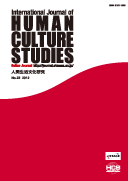Volume 2023, Issue 33
Displaying 1-12 of 12 articles from this issue
- |<
- <
- 1
- >
- >|
Original Paper
-
2023Volume 2023Issue 33 Pages 6-12
Published: January 01, 2023
Released on J-STAGE: April 08, 2023
Download PDF (700K) -
2023Volume 2023Issue 33 Pages 13-21
Published: January 01, 2023
Released on J-STAGE: May 25, 2023
Download PDF (606K) -
2023Volume 2023Issue 33 Pages 22-41
Published: January 01, 2023
Released on J-STAGE: May 25, 2023
Download PDF (5582K)
Brief Communication
-
2023Volume 2023Issue 33 Pages 63-68
Published: January 01, 2023
Released on J-STAGE: June 16, 2023
Download PDF (623K) -
2023Volume 2023Issue 33 Pages 94-100
Published: January 01, 2023
Released on J-STAGE: June 16, 2023
Download PDF (694K) -
2023Volume 2023Issue 33 Pages 127-134
Published: January 01, 2023
Released on J-STAGE: July 12, 2023
Download PDF (578K)
Errata
-
2023Volume 2023Issue 33 Pages 301
Published: 2023
Released on J-STAGE: September 16, 2023
Download PDF (227K)
Brief Communication
-
2023Volume 2023Issue 33 Pages 330-334
Published: 2023
Released on J-STAGE: October 18, 2023
Download PDF (700K) -
2023Volume 2023Issue 33 Pages 561-574
Published: 2023
Released on J-STAGE: November 24, 2023
Download PDF (625K) -
2023Volume 2023Issue 33 Pages 575-584
Published: 2023
Released on J-STAGE: December 23, 2023
Download PDF (591K)
Original Paper
-
2023Volume 2023Issue 33 Pages 599-605
Published: 2023
Released on J-STAGE: January 30, 2024
Download PDF (324K) -
2023Volume 2023Issue 33 Pages 606-620
Published: 2023
Released on J-STAGE: March 15, 2024
Download PDF (899K)
- |<
- <
- 1
- >
- >|
